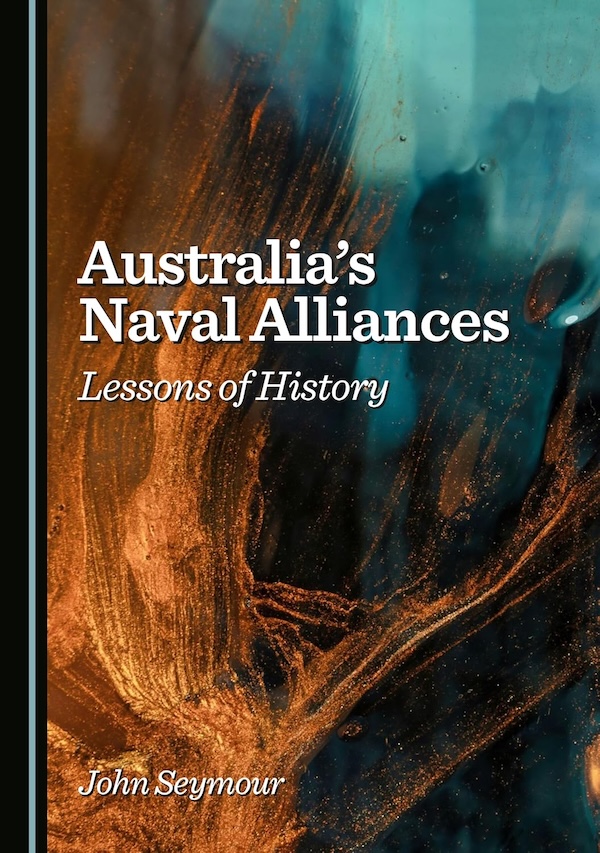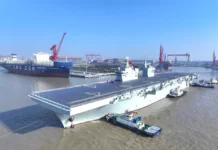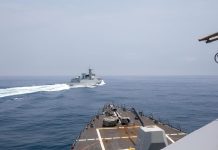
Australia’s Naval Alliances – Lessons of History. By John Seymour.Cambridge Scholars Publishing, Newcastle upon Tyne 2025.
Reviewed by John Mortimer
The author has an extensive legal background and retired as a Reader-in-Law at the Australian National University in Canberra. He is at present an Honorary Professor at that university. He authored numerous books, reports and journal articles on a range of legal topics.
John Seymour’s approach traces the development of the Navy from the early colonial period through to the end of the Second World War. Throughout he highlights the different views of the British Government and compares it to the attitude of Australian politicians, naval officers, and the media.
He draws extensively on archival records, media articles, parliamentary statements and the views of specific politicians and naval strategists involved in the overall process of defining British and Australian maritime strategy.
In the early days the British Government sought financial subsidies to fund the operations of Royal Navy ships in local Australian and New Zealand waters. The British view was one of centralised Royal Navy control of all operations. There was progressive acceptance on the development of local State Government naval forces in the colonial period and in the early years of Federation.
With Federation pressure grew to establish an Australian naval force. After Federation and the transfer of Australian State forces to the Commonwealth the main variations in policy occurred with:
– The Naval Agreement Act 1903 provided for establishment on the Australian Station of a strengthened naval force under the control of the naval commander in chief of the station. The force was part of the Imperial Navy and could be employed as required by that authority.
– At the Colonial Conference 1907 Australia’s Prime Minister, Alfred Deakin, argued that the growth of large foreign navies meant that Australia needed to acquire a Navy to provide for its local defence and protection of its trade.
– The Imperial Conference 1909 recognised the aspirations of Colonial Governments to acquire naval forces and recommended that this should comprise a Fleet Unit based on an armoured cruiser of the Indomitable class, three un-armoured cruisers, six destroyers and three submarines. A Fleet Unit was seen as Australia’s contribution to an Eastern Fleet, with other components provided by Canada and the RN.
– At the Imperial Conference 1911 Australia stated it required a fleet sufficient to protect its maritime interests. While the Royal Navy wanted control of all Colonial navies, it accepted that ultimate control would still reside with their respective Governments.
Prior to the 1911 Conference the Australian Government had placed orders in Great Britain for three torpedo boat destroyers, however after the conference it proceeded to acquire the recommended Fleet Unit. The major elements of the fleet on the outbreak of the First World War comprised the armoured cruiser, three cruisers, three torpedo boat destroyers and two submarines. A small number of Royal Navy ships on the station were also transferred to Australia.
Within Australian Governments, political views on the Navy varied between it being acquired for the defence of Australia and its interests, and the British view that their primary role was as a component of the Imperial Navy for the protection of the empire. This spread of views was also evident within the Navy.
Lack of an informed Imperial strategy for the Far East prompted the RAN to undertake a strategic review. Commander Thring’s review in 1913 followed a tour of northern Australia and its approaches. It was quite perceptive in recognising the importance of our northern approaches and identifying Japan as the most likely threat in the Pacific. It also suggested specific developments in the north and assessed that the Royal Navy would not have the capacity to conduct operations in Europe and the Pacific concurrently.
The RAN during World War One was initially employed in local waters, including operations to seize German Territory in the Pacific, the pursuit of the German Asian Squadron, protecting the deployment of Australian Army forces overseas and protection of local maritime trade. Early on it agreed to the deployment of many of its naval and land forces in the global context. The resultant impact on local naval operations was the employment of second rate vessels, ships taken up from the trade, and the tasking of Japanese naval ships in local and regional waters.
The debate on the primary purpose of the RAN continued during the later stages of the war and post war. Initially there was strong support for the fleet unit concept. Several destroyers, sloops and submarines were gifted by the RN to the RAN.
Post war Admiral Jellicoe was appointed to advise on the requirements, inter-alia, of an Australian Fleet. His recommendations outlined a significant expansion of the RAN and suggested it form a component of the proposed Eastern Fleet. This proposal was inconsistent with the Australian Government’s desire to reduce expenditure on Defence and beyond the financial and other resources that Australia could provide.
Post war disarmament conferences had a significant influence on the RAN as its ships were calculated as part of Great Britain’s naval strength. As such there were limits on what the RAN could acquire. This coupled with Government pressure to reduce expenditure on defence progressively reduced the ships in service to a small force of cruisers and destroyers to meet local and Empire naval requirements.
In the mid-1930s the prospect of war in Europe and the Pacific increased and rearmament programs were expanded in Great Britain and Australia. During the whole inter-war period a series of conferences and discussions were held to address naval strategy and these are covered in considerable detail by the author.
The Singapore strategy formed the basis of much planning during this period and resulted in the provision of some infrastructure in Australia to support the Empire’s naval forces. The development of fuel storage facilities in Darwin being an example. From the Australian perspective there was concern over the prospect of conflict emerging in both the European and Pacific theatres, and that this would limit the RN’s ability to provide an adequate force in the Pacific.
Planning in Australia continued to focus on the dual roles expected of the Navy and included purchase of three Leander class cruisers, four sloops (locally built), three Tribal class destroyers built in Australia, the local design of Bathurst class corvettes for escort and minesweeping tasks and patrol boats for local defence. Later a series of River and Bay class frigates were locally built for escort and patrol work.
As had occurred during the First World War a significant portion of the Navy’s major assets were employed in global operations prior to the commencement of hostilities in the Pacific. The loss of HM Ships Prince of Wales and Repulse demonstrated the frailty of the Singapore strategy. This was followed by other significant casualties in naval actions in the Java Sea and generally in Southeast Asian and Indian Ocean waters. Australia as a result turned its attention to forming a relationship with the US to provide for its defence. At this time the RN remaining largely impotent to provide security for those parts of its empire in the Far East.
The RAN’s warships and operations quickly and smoothly integrated within USN task group organisations, despite its RN origins and equipment. Significant RN involvement in the Pacific conflict would await the formation of the British Pacific Fleet and provision of support and other facilities in Australia to sustain their operations.
In summing up his historical analysis the author concludes:
“The pivot towards America was a re-confirmation of the dilemma which Australia, a far-flung middle power, must continue to address. Will its naval defence always rely on the maintenance of an alliance with a powerful ally? If so, the additional protection will have to be bought at the cost of problematic dependence on such an ally, a dependence which will inevitably give rise to the uncertainty, friction and diminution of sovereignty which have been the principal subjects of this book.”
In addressing AUKUS the author canvasses Australia’s earlier experiences and mentions the opportunity costs of naval ships compared to airpower, the conflicting requirements for protection of Australia’s self-reliant interests and those related to coalition operations, and loss of sovereignty. In many respects the AUKUS agreement is taking us back to the Second World War where US and later British forces used Australia to cover the southern flank of operations in the Pacific. The AUKUS arrangements complement other US forces located in Hawaii, Japan, South Korea, Guam, the Philippines, Singapore and Diego Garcia. The expansion of infrastructure in Western Australia and development of a potential east coast base for submarine operations to support the planned rotational deployments of USN and RN nuclear powered submarines, together with upgrading facilities in the Northern Territory for fuel and visits by US B-52 aircraft, as well as regular deployments of US Marine and Army elements reduces the ability of Australia to retain an independent posture. In sum these decisions strongly influence Australia’s sovereign independence and the ability to avoid conflict in which the US might seek to ensure our participation, or to mount operations from Australian territory.
This book is thoroughly researched and well written. The author’s background in legal matters is demonstrated by his forensic approach to his analysis. While his focus has been on our naval experiences, its context is equally relevant to the Army, Air Force and Defence Strategy considerations. I strongly recommend this book to all those with an interest in Strategy, Defence and Foreign Policy, as well as Navy, Army and Air Force history, force development and planning. It seems clear already that the decision to acquire nuclear powered submarines will require other Defence capabilities to be pruned or deleted, possibly resulted in an inability to undertake certain important functions, especially in areas of support, logistics and selected operational capabilities, like marine science, afloat support and aviation.



